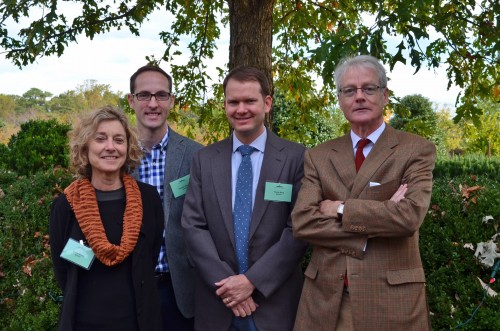Making Beauty Sustainable: Landscape Design That's Pleasing & Functional
By Kate Pyle, PR & Marketing Intern, Lewis Ginter Botanical Garden
Last week I had the opportunity to attend the Making Beauty Sustainable Gillette Forum on Landscape Design at Lewis Ginter Botanical Garden. This was a new experience for me — I don’t have a background in gardening or landscape design, but I was excited and curious all the same. The day started with presentations from Adrian Higgins, garden writer, author, columnist and editor at The Washington Post, and Thomas Rainer, landscape architect and author of a popular landscape and culture blog, groundeddesign. I feared that I would not understand most of the material, however both Higgins and Rainer were wonderful presenters, who spoke in a way that even someone like me with no landscape or design background could understand.
As the first speaker, Higgins really opened my mind to the history of landscape design. He described how we are currently in a “frightened period” where people often try to “tame” nature; we take nature out, just to put our own, tamed version of nature back in. The biggest point I took away from his presentation was that achieving a “living landscape,” in which gardens are both aesthetically pleasing and functional, is both possible and important. In the future I hope to not only buy a house, but buy a house with a yard big enough to have my own garden. Some people may have things like bungee jumping or jumping out of an airplane on their bucket list, but I prefer to keep my feet on the ground — and I’d like to use my own hands to dig up the earth and cover that ground with beautiful plants and vegetables. Higgins has inspired within me a passion to one day achieve this goal, and made me realize just how important it is.
Rainer brought up several wonderful points about the different layers of landscapes and how to vertically layer plants to make the most of every “nook and cranny” available. He broke these layers down into three sections: the upper layer: the leafless upper layer plants inhabiting different areas, sparsely throughout; the middle layer: the bulk of the design — this is what your eyes really focus on where usually one to two species are especially dominant; and last, the ground cover layer: the area most people forget about, the various grasses and species that are low to the ground. Rainer noted that we have moved to a landscape design of heavily mulched areas with a few plants sprinkled here and there in between. By utilizing the ground cover layer, instead of spreading mulch far and wide, we can use a variety of grasses and low-lying shrubs to create “green mulch.” In nature we do not find mulch or bare ground as we do in a man-made landscape design, but we do find “green mulch” or plants and grasses that grow, covering the ground layer. I highly recommend taking a look around Rainer’s blog — even I, a gardening novice (even that term seems too generous), enjoyed reading up on Rainer’s views on landscape design.
I took a lot of notes during both Higgins and Rainer’s presentations, and I hope that one day I can put them to good use in a garden of my own. For now, I will share them with you in hopes that you can put them to good use in your yard:
- Rainer believes we should reevaluate how we think about native and ecological planting. Native gardens are a big trend now, but the message of native planting is being interpreted too strictly. One doesn’t have to get rid of their exotic, non-native plants, but one should take on the design challenge of integrating native plant species with other species. Some tips for achieving this harmony:
- Observe how a plant works in nature, and how plants naturally interact with other species. Design your garden based off these interpretations.
- Consider three principles for design: plant to place (create a palette from similar habitats), plant to plant (vertically layer compatible species), and plant to people (how plants will interact with you, the emotional connection.)
- Consider that plants and landscapes in nature thrive without interference, plant plants where they might grow naturally — they might live longer.
- Examine the sociability of plants, how plants in the wild arrange themselves, and plant accordingly. Do they appear in larger clusters (a high sociability) or do they appear singularly, spread out among the landscape (low sociability). If in nature a plant is found with low sociability, plant them singularly in your garden.
- When achieving a native landscape, consider plants from other hemispheres that survive in similar conditions. Planting species that survive in similar conditions will increase chances of survival while providing a larger variety of species.
Overall, attending the forum was a wonderful experience. I’m sorry I wasn’t able to see and learn from Travis Beck and Sheila Brady who spoke after lunch with additional perspectives on ecological designs. If you attended the Gillette Forum, we’d love to hear your takeaways from these speakers and share what you learned from them.
